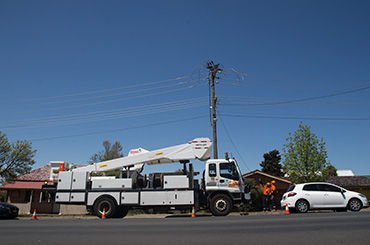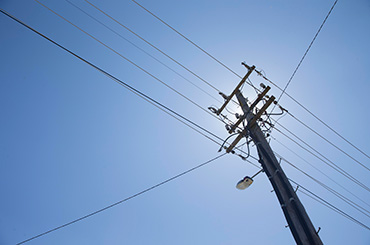
Essential Energy builds, operates and maintains the electricity network – including the poles and wires – that deliver power to 95 per cent of NSW and parts of southern Queensland. The Electricity Supply Act 1995 grants Essential Energy the authority to enter land – private and public – as necessary to construct, operate, repair and maintain this network to deliver a safe and reliable electricity supply.
We understand the importance of biosecurity and the need to prevent, eliminate or minimise biosecurity risks. Managing biosecurity is a shared responsibility between Essential Energy, government, industry, landholders, natural resource managers and the community. This responsibility relies on strong and collaborative partnerships.
Working Together
Essential Energy encourages landowners with proposed or actual accreditation with biosecurity obligations, to provide:
- The address of the property or properties at which the biosecurity obligations exist; and
- The specific biosecurity hazards related to that property (or neighbouring properties)
This information will then be entered into Essential Energy's biosecurity information system.
Complete a form to identify a potential biosecurity risk.
Bioassurance and Risk Management
Essential Energy acts to mitigate – so far as reasonably practicable – the risks involved in the movement of vehicles, equipment and people between properties to prevent, eliminate and minimise biosecurity risks.
To do this, Essential Energy considers:
- The biosecurity risk concerned;
- The degree of biosecurity impact that arises, or might arise, from the biosecurity risk;
- What is known, or ought to reasonably be known, about the biosecurity risk;
- Ways of preventing, eliminating or minimising the risk;
- The availability and suitability of ways to prevent, eliminate or minimise the biosecurity risk; and
- The cost associated with available ways of preventing, eliminating or minimising the risk, including whether the cost is grossly disproportionate to the risk.
A critical component of this approach includes:
- Gathering information from landowners regarding specific biosecurity risks on their land or adjacent areas;
- and Seeking to understand the biosecurity impact that arises from those risks.
It is a shared responsibility between Essential Energy and the landowner or manager to minimise biosecurity risks to limit the spread of pests, disease, weeds and contaminants.
Essential Energy is committed to continuing engagement with landowners and the NSW Department of Primary Industries to ensure that it complies with its duty to manage biosecurity risks.
Biosecurity Obligations and Accreditation
The Biosecurity Act of 2015 (NSW) – which came into effect on 1 July 2017 – aims to protect natural resources from the negative impact of pests, disease, weeds and contaminants on agricultural land and public spaces such as parks and reserves.
Our obligations under this Act are to take into consideration:
- Biosecurity obligations within other jurisdictions where Essential Energy assets are located; and
- Industry accreditation program requirements, such as Meat and Livestock Australia’s Livestock Production Assurance Program (MLA LPAP).
Essential Energy is currently implementing and/or further considering the following biosecurity measures:
- Prior to entry, requesting that landowners provide information on biosecurity risks relating to their property;
- A set of minimum controls for managing biosecurity risks;
- Providing staff with awareness and procedures to assess biosecurity risks at the property level;
- Development of a biosecurity information system (BIS) to identify high risk sites (e.g., dairy, intensive farming, chicken farms etc), to be used in assessing risks;
- Using information from the BIS to plan work (e.g. attend higher risk properties last);
- Providing vehicle hygiene guidance when equipment moves between regions;
- Appointment of biosecurity champions at regional locations who can build relationships with local biosecurity authorities to maintain awareness of contemporary biosecurity issues.
Biosecurity Zones and Orders
The following information aims to assist in understanding biosecurity zones and orders.
Biosecurity zones
- Used for the long-term management of an ongoing biosecurity risk or impact;
- Apply to a specific geographic area where certain actions must be taken;
- A zone area can cover the whole State, a defined part of the State, a group of neighbouring properties and/or an individual property;
- Generally used when complete eradication of biosecurity matter is not feasible but the risk is still high;
- Aim to prevent, contain and/or minimise the potential impact;
- May include eradication measures in certain areas. For example buffer areas to surround and thereby contain the pest, disease, weed or contaminant within that zone.
The Biosecurity Regulation 2017 lists the following biosecurity zones (click on the links for maps with indicative representation of the zone):
Alligator Weed
Bitou Bush
Citrus Red Mite
Grapevine Phylloxera
Lupin Anthracnose
Potato
Rice
Water Hyacinth
Emergency Orders
- Made by the Secretary of the Department of Primary Industries;
- Addresses situations of high biosecurity risk;
- Used in situations deemed to be emergencies due to a current or imminent biosecurity risk;
- For incidents with a significant biosecurity impact;
- Specifies either the emergency zone or control zone where the orders apply;
- Specifies measures required to address the specific biosecurity risk;
- May be in force for up to six months.
Control Order
- Made by the Minister for Primary Industries;
- Addresses situations to eradicate or prevent the spread of biosecurity matters;
- Specifies either the emergency zone or control zone where the orders apply;
- Specifies measures required to address the specific biosecurity risk;
- May be in force for a period of up to five years.
For more information
Biosecurity Risk Management Process Overview
Complete a form to identify a potential biosecurity risk
Australian Government Department of Agriculture and Water Resources
New South Wales Department of Primary Industries
Queensland Government Department of Agriculture and Fisheries
Meat & Livestock Australia Ltd (MLA) Livestock Production Assurance program



